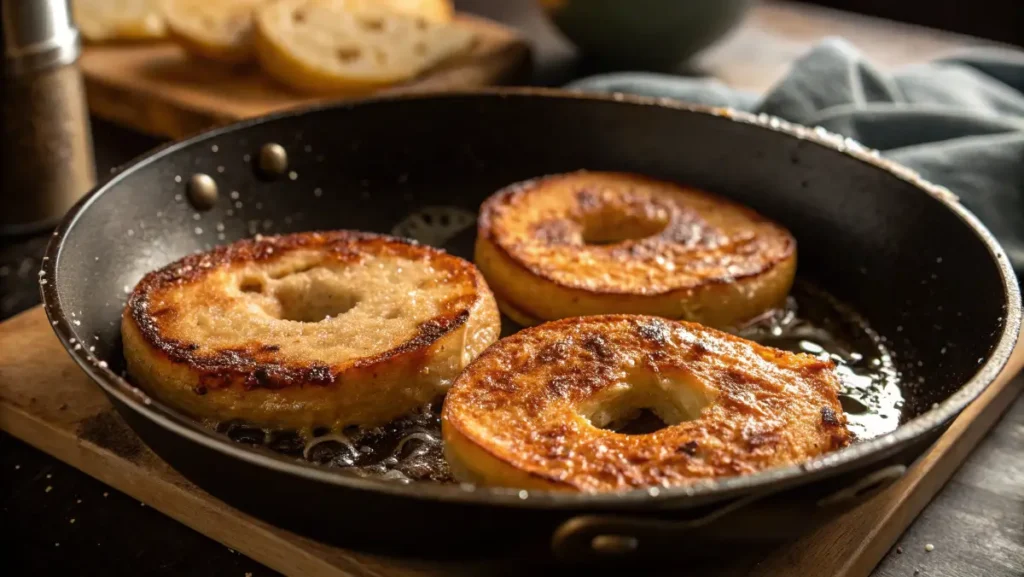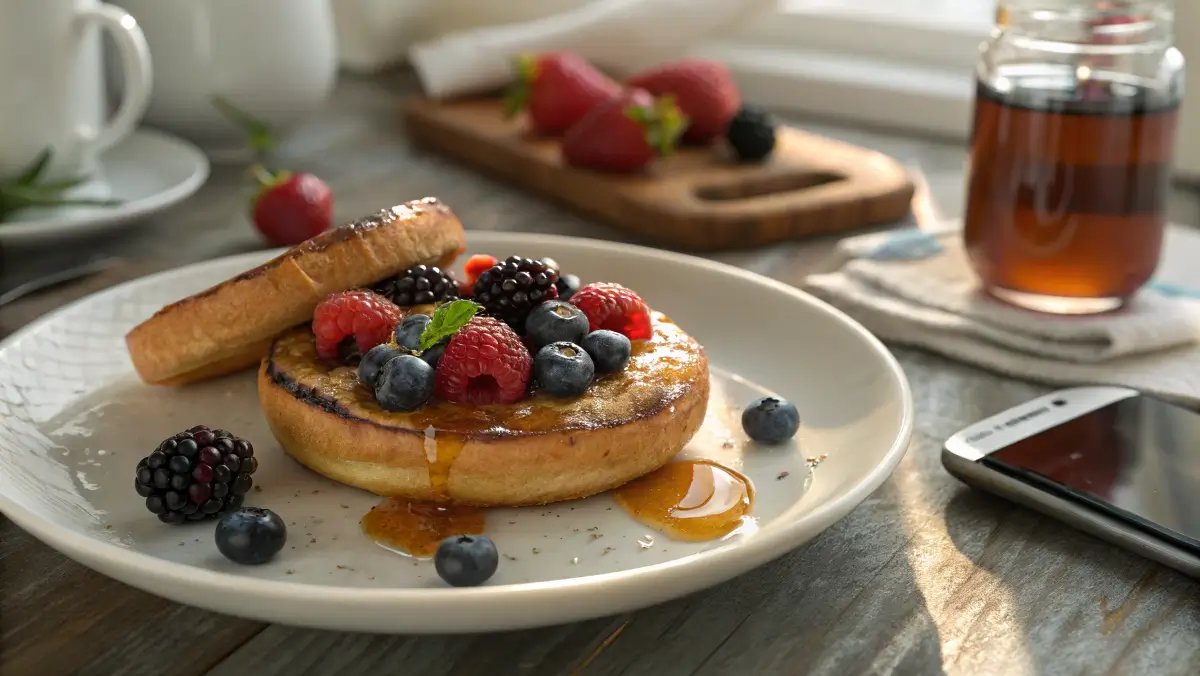The Ultimate Guide to Making the Perfect French Toast Bagel
The French toast bagel is a delightful mashup of two beloved breakfast staples, blending the dense, chewy texture of a bagel with the rich, sweet flavor of French toast. This comprehensive guide explores its background, offers detailed recipes, flavor notes, common preparation pitfalls, and even looks at how popular spots like Dunkin’ and Panera present their own versions. By the end, you’ll be well-equipped to either make your own mouthwatering French toast bagels or seek out the top versions at local cafés.
Discover great ideas like this delightful brioche French toast casserole for even more breakfast inspiration.
Table of Contents
What is a French Toast Bagel?
Origins of the French toast bagel: Where sweet meets savory
The French toast bagel is a delightful mashup born from two iconic breakfast staples—bagels and French toast. While the exact inventor is unclear, bakeries and breakfast chains began offering this treat to appeal to customers seeking a sweet, hearty start to their day. Unlike traditional French toast, which uses soft bread slices, this version uses dense, chewy bagels that soak up the custard mixture while holding their shape beautifully. The result? A rich, golden-brown exterior with a soft, slightly custardy interior that’s perfect with a drizzle of maple syrup.
Key ingredients that define a French toast bagel
A standout French toast bagel recipe starts with the basics:
- Bagels: Choose plain, cinnamon raisin, or even whole wheat bagels for a twist.
- Custard mixture: Typically made from eggs, milk (or cream), sugar, vanilla, and a touch of cinnamon.
- Butter or oil: For frying up that crispy, caramelized outer layer.
- Toppings: Think powdered sugar, fresh berries, maple syrup, or a dollop of whipped cream.
What sets a French toast bagel apart is how the bagel’s texture locks in the custard without falling apart, giving you a satisfying bite every time. The bagel’s sturdy structure makes it ideal for those who want a more substantial French toast experience. Many bakeries have also incorporated spices, swirls of cinnamon, and even stuffed fillings to elevate the flavor.
Looking for inspiration? Try this delicious bagelry gluten-free bagel idea to experiment with your base for French toast bagels.
Why Use a Bagel for French Toast?
Comparing bagels vs. traditional bread in French toast
When it comes to French toast, most people think of soft brioche or challah. But using a bagel for French toast brings a whole new level of texture and flavor. Bagels, being denser and chewier, offer a heartier bite. They soak up the egg mixture well without turning soggy, a common problem with thinner breads. While soft breads can sometimes fall apart when overly soaked, bagels hold their form, making flipping in the pan easier and less messy.
Another plus? Bagels come pre-shaped into convenient rounds with holes, which means more crispy surface area when pan-frying. That extra crusty edge around the bagel’s hole soaks up maple syrup beautifully. Learn more about creative breakfast options like this delightful brioche French toast casserole to explore alternatives to bagels or breads.
Flavor and texture advantages of using bagels
Bagels lend a satisfying chew that pairs perfectly with the creamy custard interior of French toast. Especially when you choose flavored varieties—like cinnamon raisin or blueberry—the natural sweetness shines through without needing extra sugar.
The crust on a bagel crisps up in the pan, creating contrast between the outer layer and the tender center. Plus, bagels often have a subtle yeasty flavor that complements the warm spices (like cinnamon and nutmeg) traditionally used in French toast custard.
Here’s a quick comparison table for clarity:
| Feature | Traditional Bread French Toast | French Toast Bagel |
|---|---|---|
| Texture | Soft, can get soggy | Chewy, holds shape |
| Flavor | Mild, buttery | Slightly yeasty, customizable |
| Ease of flipping | May tear when wet | Stays intact |
| Ideal for toppings | Moderate | Excellent (more crisp edges) |
Discover great ideas like this gluten-free sourdough bread alternative if you want to mix it up for your French toast bagel base!
Bagels open up possibilities for both sweet and savory French toast creations—think maple and cinnamon, or even cream cheese and smoked salmon. Their versatility means you can easily adjust your dish depending on what you’re craving.
How to Make French Toast Bagel at Home

Step-by-step recipe for homemade French toast bagels
Making a French toast bagel at home is surprisingly easy and incredibly rewarding. Here’s a simple recipe that will have your kitchen smelling like a bakery in no time:
Ingredients:
- 2 plain or cinnamon raisin bagels, sliced in half
- 2 large eggs
- 1/2 cup whole milk or cream
- 1 tsp vanilla extract
- 1/2 tsp ground cinnamon
- 1 tbsp brown sugar (optional)
- Butter or oil for frying
- Maple syrup, powdered sugar, or fruit for topping
Instructions:
- In a shallow bowl, whisk together the eggs, milk, vanilla, cinnamon, and brown sugar until smooth.
- Place bagel halves cut-side down in the mixture. Let them soak for 30 seconds, flip, and soak the other side. Don’t oversoak or the bagel may become too soft.
- Heat a skillet over medium heat and add a pat of butter or a drizzle of oil.
- Fry the bagels for about 2-3 minutes per side, or until golden brown and cooked through.
- Enjoy warm, topped with maple syrup, a dusting of powdered sugar, or any toppings you love.
Pro tip: If you’re using day-old or slightly stale bagels, they’ll soak up the custard beautifully without falling apart.
Check out this easy protein overnight oats for a perfect high-protein pairing at breakfast.
Essential tools and tips for the best results
To nail your French toast bagel every time, having the right tools makes a difference:
- Non-stick skillet or griddle: Prevents sticking and makes flipping easier.
- Flat spatula: Essential for evenly flipping the bagels without breaking them.
- Use a shallow bowl so the bagels absorb the custard mixture evenly.
Tips for success:
- Don’t soak the bagels for too long—30 seconds per side is usually enough.
- Cook over medium heat—anything higher can scorch the outside while leaving the inside undercooked.
- Experiment with bagel flavors. Cinnamon raisin, blueberry, or even whole wheat bagels work great.
For more breakfast inspiration, don’t miss this PCOS-friendly breakfast roundup filled with nutritious ideas.
French Toast Bagel Taste and Texture Explained
What does a French toast bagel taste like?
A French toast bagel offers a unique blend of flavors that’s both familiar and exciting. The bagel itself brings a slightly yeasty, hearty base that pairs perfectly with the sweet, spiced custard coating. When cooked, the exterior develops a golden, crisp layer, while the inside stays tender with just enough chew to satisfy. If you choose flavored bagels like cinnamon raisin or blueberry, the taste becomes even richer, adding natural sweetness and fruity undertones. The vanilla and cinnamon in the custard enhance the overall warmth and depth of flavor. The end result is a dish that feels indulgent but balanced, offering just the right amount of sweetness without overwhelming your palate.
How texture changes when bagels are used
Texture is where the French toast bagel truly shines. Compared to soft bread slices, a bagel’s denser crumb allows it to soak up the custard without falling apart. This results in a firm, slightly chewy center that contrasts beautifully with the crisp, caramelized crust. The hole in the bagel also creates extra edges that crisp up in the pan, adding more crunch to each bite. You get multiple textures in one dish: a crispy outer shell, a creamy custard layer beneath, and a satisfying chewy core. That’s why so many breakfast lovers find French toast bagels more enjoyable and filling than traditional French toast.
French toast bagels are ideal for those who like a bit of bite and structure in their breakfast. You can also add toppings that bring more texture—such as chopped nuts, fresh berries, or a sprinkle of granola. For another layered breakfast idea.
Discover great ideas like this cottage cheese banana bread that pairs moistness with a hint of sweetness.
Common Mistakes When Making French Toast Bagel
The #1 mistake most home cooks make
One of the most common mistakes when preparing a French toast bagel is soaking the bagel too long in the custard mixture. Bagels are sturdy, but they’re not invincible. If left to soak for more than a minute per side, the bagel can become overly saturated. This leads to a soggy texture that cooks unevenly, leaving you with a burnt exterior and a mushy center. The key is balance. Dip the bagel halves just long enough to coat them fully—usually about 30 seconds per side is ideal. This allows the custard to flavor the bagel without overwhelming its structure.
How to avoid soggy or burnt French toast bagels
Another common pitfall is cooking the French toast bagel on heat that’s too high. When the pan is too hot, the outer layer burns before the custard inside has a chance to set. The solution is to cook on medium or medium-low heat. This ensures that the custard cooks through gently while the outside turns golden and crisp.
Don’t overcrowd the pan. Giving each bagel half room allows for even cooking and easier flipping. A non-stick skillet or well-seasoned cast-iron pan works best to prevent sticking and promote a uniform crust. Finally, be sure to preheat your skillet properly before adding the bagels. A consistent heat makes a big difference in the final texture.
Looking for inspiration? Try this easy protein overnight oats as a no-fail breakfast side that’s quick and nutritious.
Popular French Toast Bagel Variations

Cinnamon swirl and stuffed French toast bagel ideas
A French toast bagel is a versatile breakfast dish, and there are countless ways to customize it. One popular variation is using cinnamon swirl bagels. These bagels have ribbons of cinnamon sugar baked into them, adding extra sweetness and spice without needing additional toppings. When dipped in custard and pan-fried, they develop a caramelized crust that enhances the natural flavor of the bagel.
Stuffed French toast bagels take things a step further. Before dipping in the custard, you can spread cream cheese, fruit preserves, or even Nutella between the bagel halves. Once cooked, the filling becomes warm and gooey, creating a decadent center that contrasts with the crispy exterior. This style works well for brunch gatherings or special occasions because it feels indulgent yet easy to prepare.
Healthier options: whole wheat, gluten-free, or dairy-free
If you’re looking to lighten up your French toast bagel, consider whole wheat or gluten-free bagels. Whole wheat bagels provide more fiber and a heartier flavor that pairs nicely with maple syrup and fresh fruit. Gluten-free bagels are a great option for those with dietary restrictions and can be found in most grocery stores.
For a dairy-free version, substitute almond milk, oat milk, or coconut milk in the custard mix. You can also use coconut oil or plant-based butter for frying. These simple swaps maintain the rich, satisfying flavor of French toast bagel while making it suitable for various dietary needs.
Check out this gluten-free sourdough bread if you’re exploring more gluten-free breakfast bases.
French Toast Bagels on Menus
Does Panera still have French toast bagels?
Panera’s French toast bagel was once a popular menu item, known for its sweet cinnamon flavor and soft, chewy texture. It combined the best of French toast spices with the satisfying bite of a bagel. However, Panera has removed the French toast bagel from most of its locations. This change disappointed many loyal fans who loved pairing it with cream cheese or using it as the base for breakfast sandwiches. Panera periodically updates its menu to focus on seasonal offerings or healthier options, and unfortunately, the French toast bagel didn’t make the cut in recent years.
If you’re craving that nostalgic flavor, making your own French toast bagel at home is a great alternative. The homemade version lets you control the ingredients and add your favorite toppings or fillings.
Does Dunkin Donuts offer French toast bagels?
Dunkin Donuts, another major player in the breakfast world, has also experimented with sweet bagel varieties, but it doesn’t currently offer a French toast bagel as a regular menu item. While Dunkin has featured cinnamon raisin and multigrain bagels, a dedicated French toast flavor hasn’t been widely available. However, many customers get creative by ordering bagels with cinnamon-flavored cream cheese or maple syrup drizzle to achieve a similar taste profile.
If you’re looking for more unique breakfast ideas, check out this PCOS breakfast recipe collection to inspire your next morning meal.
Pairing Ideas and Serving Suggestions
Best toppings for French toast bagels
The beauty of a French toast bagel is how well it pairs with a variety of toppings. Classic choices like maple syrup and powdered sugar highlight its sweetness without overpowering the warm cinnamon and vanilla flavors. Fresh berries, banana slices, or apple compote add natural sweetness and a bit of acidity that balances the richness. If you’re looking for extra texture, consider sprinkling chopped nuts or granola on top for a satisfying crunch.
For those who prefer a more indulgent take, a smear of flavored cream cheese, a drizzle of honey, or a dollop of whipped cream can transform your French toast bagel into a true brunch-worthy dish. Even savory toppings like bacon crumbles or a touch of sea salt caramel can create a sweet-and-salty contrast that’s hard to resist.

Ideal drinks and sides to serve
A French toast bagel pairs wonderfully with a variety of drinks and sides. Coffee and tea are classic choices that complement the dish’s warm, spiced flavors. For something refreshing, try a glass of fresh orange juice or a fruit smoothie. If you want a more filling meal, serve your French toast bagel with scrambled eggs, crispy bacon, or turkey sausage on the side.
For a balanced breakfast spread, consider adding a simple fruit salad or a small bowl of Greek yogurt topped with honey. If you’re interested in other hearty breakfast ideas, check out this crockpot steak and potato bake for a savory addition to your morning table.
French Toast Bagel: Nutritional Info and Storage Tips
Calorie count and nutritional breakdown
A typical French toast bagel made with a plain bagel, egg custard, and a small amount of butter contains about 350 to 450 calories per serving, depending on the size of the bagel and the amount of toppings added. Cinnamon raisin or stuffed versions may be slightly higher in calories due to added sugar and fillings. Nutritionally, a French toast bagel provides a good mix of carbohydrates from the bagel, protein from the eggs, and fat from the cooking oil or butter. If you use whole wheat or gluten-free bagels, you can boost the fiber content.
Here’s a simple breakdown for one serving (without toppings):
| Nutrient | Amount (approx.) |
|---|---|
| Calories | 400 |
| Carbohydrates | 50g |
| Protein | 14g |
| Fat | 16g |
| Fiber | 3g |
| Sugar | 8g |
Choosing healthier toppings like fresh fruit or a drizzle of honey can keep your French toast bagel both nutritious and satisfying.
How to store and reheat French toast bagels
French toast bagels are convenient to store and simple to reheat. Let any leftovers cool fully before sealing them in an airtight container. In the fridge, they’ll remain fresh for up to three days. For longer storage, wrap each cooked bagel in plastic wrap or foil and then transfer them to a freezer-safe bag. Properly stored, they can last in the freezer for up to two months.
To reheat, simply place the bagel halves in a toaster oven or on a skillet over medium heat until warmed through and crispy. Avoid microwaving as it tends to make the texture rubbery. For more make-ahead breakfast ideas, discover great ideas like this cottage cheese dessert recipe for a nutritious and sweet ending to your meal.
Conclusion
French toast bagels are a fantastic way to elevate your breakfast routine. With their rich flavor, satisfying texture, and endless pairing possibilities, they’re perfect for busy mornings or weekend brunches. Whether you choose to make them with classic plain bagels, cinnamon swirls, or stuffed variations, they deliver comfort and flavor in every bite. Don’t miss our delicious brioche French toast casserole if you’re ready to explore more sweet breakfast creations.
FAQs
Can you use a bagel for French toast?
Yes, you can use a bagel for French toast, and it works beautifully. Bagels are denser than regular bread, so they absorb just enough custard without falling apart. Their sturdy texture gives a satisfying chew and crisp edges after cooking.
What does a French toast bagel taste like?
A French toast bagel tastes like the perfect blend of sweet and savory. The bagel’s slight yeastiness pairs with the creamy custard and warm spices like cinnamon and vanilla. The result is a crispy outside and tender, custardy center with just the right amount of sweetness.
What is the most common mistake when making French toast?
The most common mistake is soaking the bagel or bread too long in the custard mixture. This leads to soggy results that cook unevenly. A quick soak ensures a balanced texture with a crisp crust and soft interior.
Does Panera still have French toast bagels?
No, Panera has discontinued its French toast bagel in most locations. It was once a favorite, known for its cinnamon-sugar coating and sweet flavor, but it is no longer a regular menu item.
Does Dunkin Donuts have French toast bagels?
Dunkin Donuts does not currently offer a French toast bagel. While they have various bagel flavors, including cinnamon raisin, a dedicated French toast bagel is not part of their standard menu.
What menu items did Panera get rid of?
Panera has phased out several items over the years, including the French toast bagel, the chipotle chicken panini, and various seasonal salads. These changes reflect menu updates focused on fresh and health-conscious options.

